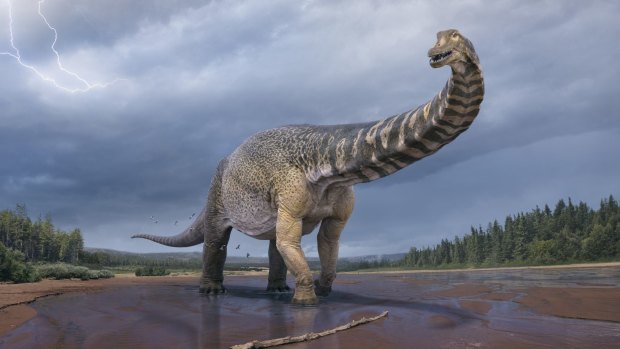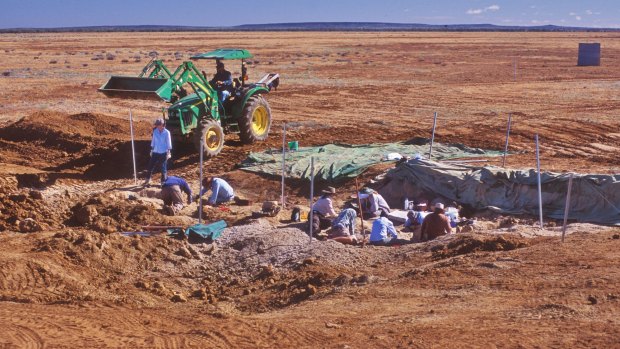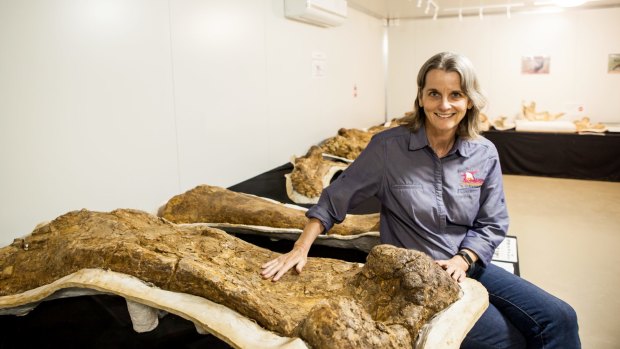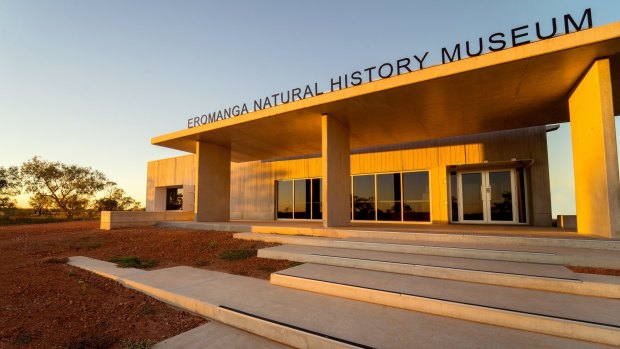This was published 4 years ago
Australia's largest dinosaur discovered: How to join fossil digs with Eromanga Natural History Museum

What Australotitan cooperensis, 'Cooper', the Southern Titan, may have looked like.Credit: Vlad Konstantinov
On my drive to Eromanga Natural History Museum this morning I picture the scene from Jurassic Park where Sam Neill and Laura Dern make first contact with the dinosaurs, set to that dramatic John Williams score, just before Richard Attenborough announces: 'Welcome to Jurassic Park'.
There's no dinosaurs along the road in - just a couple of bloated cattle struck by road trains on a lonely highway patrolled by wedge-tailed eagles – but the earth around here is full of their bones. This is Australia's dinosaur graveyard – and it's fast becoming one of the world's most significant bone and fossil areas.
On Monday last week, the museum announced they'd formally identified the biggest dinosaur ever found in Australia. Found close by, Cooper, as the animal has been dubbed, is one of the biggest dinosaurs ever found anywhere on the planet. He's as long as a basketball court, two storeys high and between 93 and 96 million years old. He's also a brand-new species that's never been found anywhere before.

Participants excavating at the 2007 'Cooper' dinosaur dig site.Credit: Gary Cranitch
I'm on my way to see what remains of him. And to take part in a new fossil preparation program that allows me to work with dinosaur and mega-fauna fossils, one of the only places in the world you can do so.
I should confess: I know nothing about dinosaurs, I failed science at school. But the museum tells me all I need is a steady hand, a good eye for detail, a have-a-go attitude, a head for puzzles, a good dose of patience and persistence and I should enjoy working with a team. Two from seven is ok, right? I keep to myself that my brothers called me Mr Common-Senseless through my childhood.
The Eromanga Natural History Museum is one of the biggest and most accessible dinosaur museums in the world, impressive considering it's built beside a town of 119 residents in the middle of outback Queensland. You can stay right next door to it, at a new lodge named after Eromanga's most famous resident (Cooper's Country Lodge).

Robyn Mackenzie, Eromanga Natural History Museum director and paleontologist with Cooper's fossilised bones.Credit: Steve Young
Video: Australia's largest dinosaur
On the museum's hour-long guided tour I see Cooper up close (his right femur alone measures nearly two metres). The discovery of this Australotitan cooperensis (the southern titan) has marked Australia's entry into the league of giant dinosaurs only previously discovered in South America (the largest dinosaur was found in Argentina).
"This is definitely Australia's Eureka moment," Eromanga Natural History Museum director Robyn Mackenzie says. "It's huge. There's never been anything found this big in our country, and it's our very own unique Aussie species. This dinosaur is nearly 30 metres long."

The Eromanga Natural History Museum.Credit: Steve Young
Mackenzie and her husband Stuart are the lifeblood of this place. Her son Mark was the first to find dinosaur bones in the region - on the family farm in 2004. This confirmed Stuart's belief the area was full of dinosaur bones. Ever since, the Mackenzies have led the race to uncover what's beneath us. There's over 70 sites still to be evacuated.
She's a worthy person then (she's also a field palaeontologist) to lead me through my fossil preparation program. Visitors can take part in a series of programs to handle the bones and fossils uncovered in digs. There's a fossil preparation family program offering a 90 minute opportunity to work with fossils. For those over 18, there's anything from one to 10 day fossil preparation programs.
I'm doing the one-day program. I'm led into a lab, given a white lab suit, a bowl of acetone, a dentist probe and a chunk of rock. Today I'll work with fossils of mega-fauna which roamed these parts between 50 000 and 100 000 years ago.
Mackenzie tells me to think like a surgeon, to slowly work away at the sediment in the rocks to uncover what's inside. This is the patience part.
"Scrape, don't dig, be gentle, think like a surgeon," she advises. "One of Cooper's pelvis bones took me an entire year to prepare, and that was just one side."
As the minutes go by, I see rock slowly turn into something else. The more I squirt, and scrape, the more I see. Patterns emerge, memories of creatures that came so long before me.
"With mega-fauna, guests get almost instant results," Mackenzie says (if you commit to multiple-day fossil preparation programs you'll get to work with dinosaur fossils and bones where the results take longer).
"You imagine, what you're seeing has been covered for 100 000 years, and 90-odd million with the dinosaurs, and you're the first to see it again. It's pretty easy to drift back to those times, and to think they would've all walked right across this museum."
Should I wish to go beyond, visitors can join in a range of dig experiences, working with field palaeontologists and geologists for five days at nearby sites (there's space for 24 guests across four weeks). Two weeks ago, Mackenzie and her team uncovered large parts of a tailbone, vertebrae and possible scapulars from a massive plant-eating dinosaur there.
It's almost dark when I leave the lab - there's still no T-Rex's in the carpark, but if I think of the fossils and bones I've been working on, it's not hard to picture a Southern Titan walking by me here on these sandy plains, Sam Neill's Dr Allan Grant following in pursuit.
THE DETAILS
VISIT
The Emoranga Natural History Museum offer a range of fossil prep and dig programs, see enhm.com.au
STAY
Stay on site at four-star Cooper's Country Lodge, see enhm.com.au/accomadation/
FLY
Fly to Charleville with Rex (rex.com.au) or Qantas Link (qantas.com.au), then hire a 4WD with Avis (avis.com.au). Eromanga is three-hours-20-minutes' drive west.
The writer travelled courtesy of Tourism & Events Queensland
Sign up for the Traveller Deals newsletter
Get exclusive travel deals delivered straight to your inbox. Sign up now.